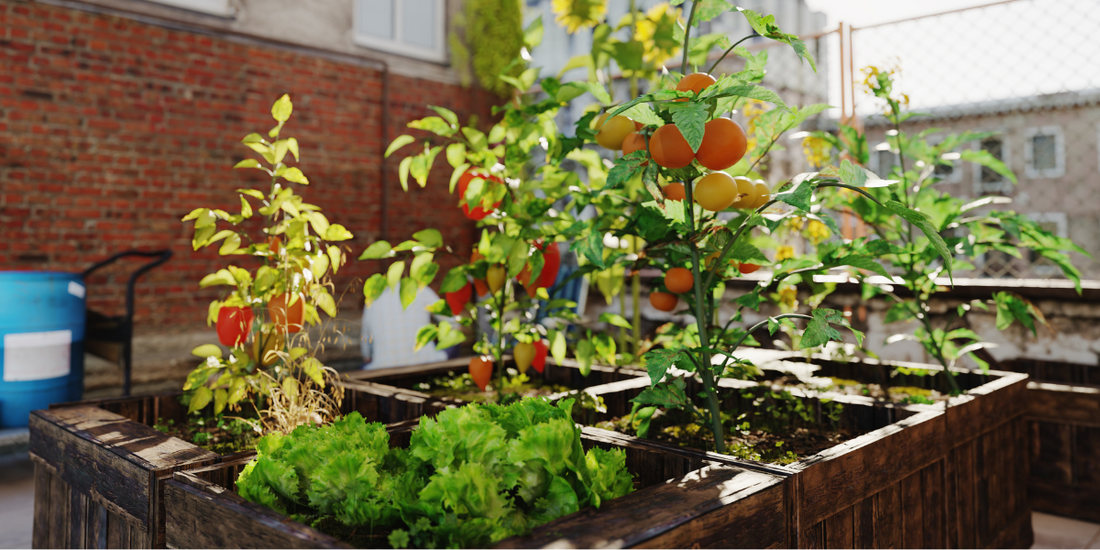
How To Start a Successful Urban Gardening
Share
Urban gardening isn't complicated. It's about finding creative ways to grow fresh produce in urban spaces, like balconies, rooftops, or even indoors. In this guide, we'll cover everything you need to know to get started. But urban gardening is about more than just planting. It's also about improving air quality, reducing stress, and building community connections. We'll explore the many benefits of urban gardening and how it can enhance your quality of life in the city.
So, whether you're dreaming of a balcony full of flowers or a rooftop garden with fresh veggies, this guide will help you turn your urban gardening dreams into reality. Let's get started and bring a little piece of nature into your city life!
What is Urban Gardening
Urban gardening, also known as urban agriculture, encompasses the practice of growing food within urban environments. According to the Food and Agriculture Organization, it includes various forms such as urban farming and vegetable gardening. This involves cultivating vegetable plants and flowering plants in limited spaces like balconies, rooftops, or community gardens within cities. Urban gardening promotes sustainability and provides access to fresh produce, contributing to local food security and enhancing urban green spaces.
Types of Urban Gardening
Urban gardening encompasses various approaches that cater to the diverse spatial constraints and preferences of urban dwellers. Here are several types of urban gardening:
Container Gardening:
Container gardening is a popular choice in urban environments with limited space. It involves growing plants in containers such as pots, hanging baskets, or window boxes. This method allows individuals to cultivate a variety of plants on balconies, patios, or even indoors, making it an ideal solution for those without access to traditional garden beds.
Vertical Gardening:
Vertical gardening utilizes vertical spaces to grow plants, often on walls or structures. Vertical gardens are space-efficient and can be implemented in various forms, such as vertical planters, trellises, or living walls. This approach maximizes the use of available space, making it suitable for urban areas with limited ground space.
Rooftop Gardening:

Rooftop gardening involves transforming rooftops into productive green spaces. It utilizes the often underutilized rooftop areas of buildings for growing a variety of plants, from vegetables and herbs to ornamental flowers. Rooftop gardens offer environmental benefits, including insulation for buildings and reduced urban heat island effects.
Community Gardening:
Community gardens are shared spaces where multiple individuals or families collectively cultivate and maintain plots. These gardens foster a sense of community, allowing people to share knowledge, resources, and the joy of gardening. Community gardens can be found in various urban settings, including parks, vacant lots, or designated garden spaces.
Indoor Gardening:
Indoor gardening brings the greenery inside, allowing individuals to grow plants within their homes. This method is well-suited for apartments or homes without outdoor spaces. Indoor gardens can include potted plants, herb gardens on windowsills, or more complex setups using hydroponics or aquaponics systems.
Balcony Gardening:
Balcony gardening focuses on utilizing balcony spaces to create small, but productive, gardens. This approach often involves container gardening and is suitable for individuals who have limited outdoor spaces. Balcony gardens can include different plant varieties, including growing vegetables, flowers and herbs.
Guerrilla Gardens:
Guerrilla gardening involves transforming neglected or abandoned public spaces into green areas without formal permission. Individuals or groups engage in covert planting to beautify and reclaim unused land. Guerrilla gardening aims to enhance the urban environment, promote sustainability, and encourage community involvement.
Aquaponic and Hydroponic Gardens:
Hydroponic and aquaponic systems are soil-less gardening methods that use nutrient-rich water to cultivate plants. Hydroponics involves growing plants directly in water, while aquaponics integrates fish farming with plant cultivation, utilizing the nutrient-rich water from fish tanks to nourish the plants. These systems are space-efficient and suitable for urban environments.
Community Gardens:
Community gardens are designated plots of land provided to individuals or families for personal cultivation. Often found in urban areas, these plots allow people to grow their own food and contribute to a sense of community. Community gardens provide a larger space compared to container or balcony gardening, offering the opportunity to cultivate a variety of crops.
Urban Gardening Tips To Start Your Own Garden
Starting a successful urban gardening venture involves careful planning, consideration of space constraints, and a commitment to sustainable practices. Here are key steps to help you establish a thriving urban garden:
Site Selection:
Choose an appropriate location for your urban garden, considering factors like sunlight exposure, soil quality, and accessibility. Assess available spaces such as rooftops, balconies, community plots, or even vertical gardens. Ensure the chosen site receives an adequate amount of sunlight, as most plants require sunlight for healthy growth.
Container Gardening:
Due to limited space in urban environments, consider container gardening as a practical solution. Growing plants in pots is one of the best solutions for a limited space in urban areas. Select containers of various sizes and materials, ensuring they have proper drainage to prevent waterlogging. This approach allows flexibility in arranging plants and makes it easier to adapt to different urban settings.
Soil Preparation:
Invest time in soil preparation to provide a nutrient-rich foundation for your plants. Use a high-quality potting mix or compost that suits the needs of your chosen crops. Regularly amend the soil with organic matter to enhance fertility and water retention. Avoid using plain soil in containers. It tends to compact and may include weeds and disease.
Choose Suitable Plants:
Select crops that are well-suited to your climate, available space, and the specific conditions of your urban environment. Consider factors such as the length of the growing season, temperature variations, and the space requirements of each plant. Herbs, salad greens, and compact vegetables are often ideal choices for urban gardening.
Watering System:
Establish an efficient watering system to ensure consistent moisture for your plants. Use drip irrigation, soaker hoses, or self-watering containers to minimize water wastage and provide a steady supply to the roots. If practical, these can be more efficient and consistent than hand watering. Be mindful of water conservation practices to promote sustainability.
Incorporate Organic and Sustainable Practices:
Embrace organic gardening methods to cultivate a healthy and environmentally friendly urban garden. Avoid synthetic pesticides and fertilizers, opting instead for natural alternatives. Implement companion planting strategies to deter pests and enhance soil fertility. Compost kitchen waste to create nutrient-rich soil amendments.
Maintaining Your Urban Garden
Maintaining an urban garden requires ongoing attention and care to ensure the health and productivity of your plants. Here are essential tips for effective maintenance:
Regular Watering:
Consistent and adequate watering is crucial for the well-being of your plants. Establish a watering schedule based on the specific needs of your crops and the prevailing weather conditions. Use a drip irrigation system, soaker hoses, or watering cans to deliver water directly to the soil, avoiding wetting the foliage to prevent diseases if practical.
Weeding:
Regular weeding is essential to prevent unwanted plants from competing for nutrients and space. Remove weeds by hand or use mulch to suppress their growth. Mulching also helps retain soil moisture and regulates temperature, creating a more favorable environment for your plants.
Fertilization:
Provide nutrients to your plants through organic fertilizers or compost. Regularly assess the soil fertility and adjust your fertilization approach accordingly. Avoid over-fertilizing, as it can lead to nutrient imbalances and negatively impact plant health.
Pest and Disease Management:
Monitor your garden for signs of pests and diseases. Identify issues early to prevent widespread damage. Implement integrated pest management strategies, such as introducing beneficial insects, using companion planting techniques, or employing natural remedies like neem oil or insecticidal soap.
Soil Maintenance:
Periodically assess the quality of your soil and make necessary amendments. Add compost to enhance fertility and improve soil structure. Rotate crops to prevent soil-borne diseases and avoid depleting specific nutrients. Mulching with organic materials helps conserve moisture and regulates soil temperature.
Support Structures:
Provide adequate support for tall or vining plants to prevent them from bending or breaking under the weight of the produce. Use stakes, trellises, or cages to support plants such as tomatoes, peas, or beans. Regularly check and adjust the supports as the plants grow.
Benefits of Urban Gardening Benefits
Here are some advantages of growing your own urban vegetable gardens
1. Environmental Sustainability:
Urban gardening plays a crucial role in promoting environmental sustainability by mitigating the ecological footprint associated with food production and transportation. When individuals cultivate their own fruits, vegetables, and herbs locally, it reduces the need for long-distance transportation and the associated carbon emissions. Additionally, urban gardens contribute to biodiversity by providing green spaces in concrete-dominated environments, supporting pollinators, and fostering a healthier ecosystem. The reduction of chemical inputs and the promotion of organic practices in urban gardening further enhance the overall environmental sustainability of this practice.
2. Fresh Organic Food Accessibility and Security:
One of the primary benefits of having your urban vegetable garden is its contribution to food security and accessibility. By growing fresh produce within the city limits, individuals have the opportunity to access homegrown healthy food, which is particularly important in areas with limited access to grocery stores or fresh food. Urban farms or gardens empower communities to take control of their food sources, promoting self-sufficiency and reducing reliance on external supply chains. This aspect becomes particularly significant during times of crisis, such as natural disasters or disruptions in the global food distribution system.
3. Community Building:
Urban gardening serves as a powerful catalyst for community building and social interaction. Shared gardening spaces create opportunities for neighbors to collaborate, share knowledge, and collectively work towards a common goal. Community gardens often become focal points for social gatherings, workshops, and events, fostering a sense of belonging and mutual support among residents. As individuals come together to cultivate the land, they build stronger connections, share resources, and develop a collective sense of responsibility for the well-being of their neighborhood.
4. Physical and Mental Health Benefits:
Engaging in urban gardening offers a range of physical and mental health benefits. The physical activity involved in planting, weeding, and harvesting provides a form of exercise, contributing to improved fitness levels and overall well-being. Moreover, spending time in green spaces has been linked to reduced stress, anxiety, and depression. Urban gardens, whether on rooftops, balconies, or community plots, offer individuals an opportunity to connect with nature within the confines of an urban environment, promoting mental clarity and a sense of tranquility.
Challenges of Urban Gardeners
Urban gardeners face several challenges unique to their environment. Limited space is perhaps the most prominent issue, forcing gardeners to be creative in maximizing every inch for plant growth. Urban areas also tend to have poor soil quality and limited access to natural light, requiring gardeners to supplement with artificial lighting and invest in quality soil amendments. Additionally, urban gardens may be more susceptible to pollution, pests, and theft, necessitating vigilant pest management and security measures. Despite these challenges, urban gardeners demonstrate resilience and ingenuity, transforming urban landscapes into vibrant green spaces that contribute to the health and well-being of their communities.
Conclusion
In conclusion, urban gardening is a rewarding journey that allows you to bring nature into your city life. By following the tips and techniques outlined in this guide, you can create a thriving garden in even the smallest urban spaces.
Remember to choose the right plant for suited to your area, whether you have a sunny balcony or a shady corner indoors. Use containers that suit your available spaces and don't be afraid to get creative with your gardening solutions.
Maintaining your garden doesn't have to be complicated. Just keep an eye on watering needs, provide adequate sunlight, and fertilize your plants to keep them healthy and happy.
Above all, have fun with your urban garden! Experiment with different plants, designs, and layouts to create a spaces that reflects your personality and brings you joy. Happy gardening
